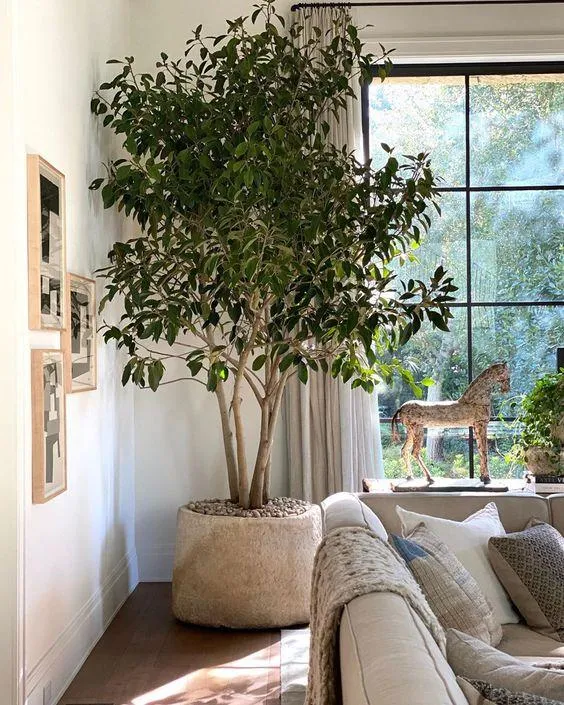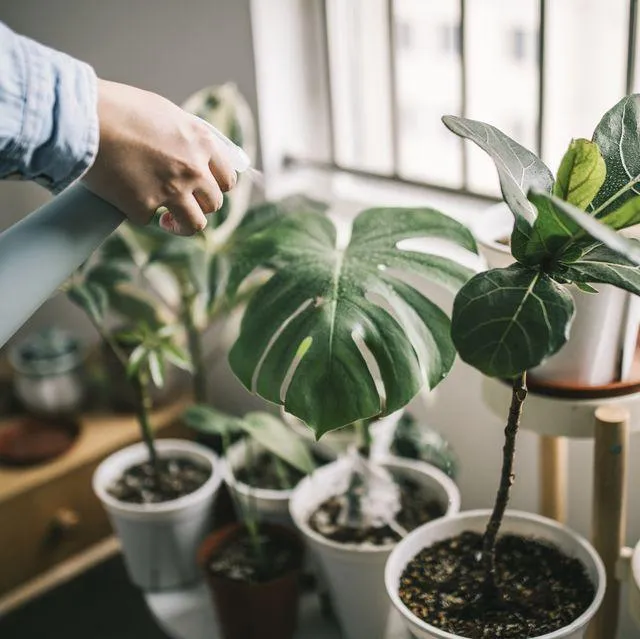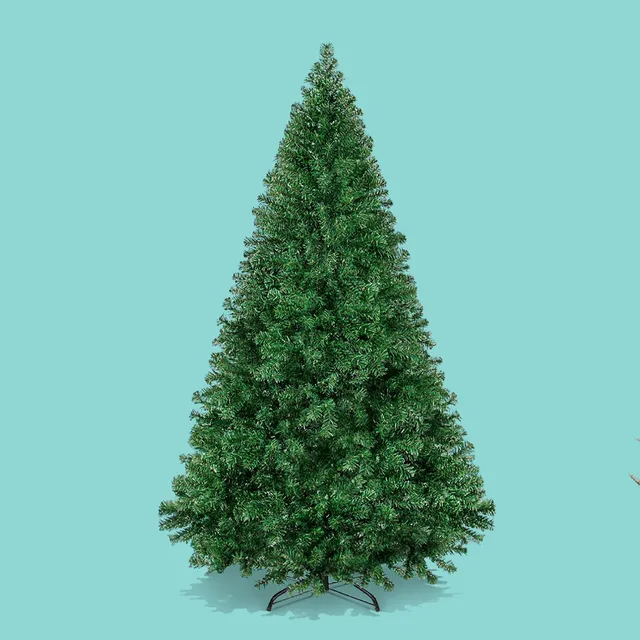The Easiest Trees to Grow Indoors: Choosing and Caring for Houseplants Trees
Are you looking for some fresh greenery to brighten up your home but don’t have a yard? Houseplants trees may be the perfect solution. In this article, I’ll discuss the easiest tree varieties to grow indoors and provide tips for choosing, caring for, and maintaining trees inside your home.
Top Tree Varieties for Indoor Growing
- Chinese Evergreen (Aglaonema): From my experience, the Chinese evergreen is one of the most forgiving houseplants. It thrives in low to medium indirect light and tolerates occasional dry soil. Just water when the top inch of soil is dry. It comes in many varieties with bright green, variegated, or dark foliage.
- Dwarf Date Palm (Phoenix roebelenii): The dwarf date palm has a nice tropical appearance and is fairly lightweight, making it easy to transport. It prefers bright, indirect light and moderate water —allow the top inch of soil to dry between waterings. Prune off dead or dying fronds as needed.
- Dumb Cane (Dieffenbachia): Dumb cane is toxic if ingested by humans or pets, so place it out of reach of children and animals. However, it’s very hardy and thrives in medium to low light. Only water when the top inch of soil feels dry.
Other Good Options
In addition to the top choices above, here are some other tree varieties that generally thrive when grown indoors:
– Fern Tree (Cycad): Low light tolerant and very drought resistant once established.
– Nathaniel Hawthorn (Raphiolepis indica): Stylish small tree with dark green oval leaves. Adaptable to varying light.
– Rubber Plant (Ficus elastica): Thick, lush leaves tolerate low light. Allow topsoil to dry between waterings.
– Dracaena (Dracaena marginata): Colorful foliage in shades of yellow, red, and green. Very forgiving of under or over-watering.
– Parlour Palm (Chamaedorea elegans): Delicate fronds on a compact plant. Prefers medium light and moist soil.
The varieties above are fairly easygoing as long as their light and watering needs are met. Their size also works well for indoor growing. The key is choosing a tree that matches your home’s lighting conditions.
Tips for Choosing an Indoor Tree
When selecting a tree for indoor growing, consider these factors:
– **Light conditions:** Evaluate windows and assess bright, medium, or low light. Match the tree to your space. Kind of like how I have to choose low-light plants for my apartment.

– **Size:** Smaller varieties (under 5 feet tall) typically adapt better to indoor life. Measure height/width clearance.
– **Water needs:** Choose moderate water drinkers to match your schedule. Drainage is key too—healthy roots don’t like soggy soil.
– **Hardiness:** Opt for very hardy and forgiving types to survive inevitable mistakes. You won’t kill a Chinese evergreen as easily as a delicately fussy tree.
– **Toxicity:** Keep trees away from pets or kids if parts are poisonous if ingested. That dumb cane is no joke!
Taking these points into account will help you pick a tree suited for thriving inside your home, not just barely surviving. With the right variety, trees absolutely sort of make amazing indoor plants.
Caring for Your Indoor Tree
Once you’ve selected a tree, follow these general care instructions to keep it looking its best:
- Light: Place in a bright spot, but protect from direct sun, which can scorch leaves. Rotate weekly so all sides get even exposure.
- Water: Water when top inch of soil becomes dry. Check soil moisture with your finger, not just a schedule. Underwatering is safer than overwatering.
- Humidity: Trees prefer humid conditions like forests. Use a pebble tray or humidifier especially in low-humidity heated homes during winter.
I’ve seen trees struggle without extra humidity control indoors. - Fertilizer: Feed with diluted liquid houseplant fertilizer monthly in spring/summer when tree is actively growing.
- Pruning: Remove damaged, diseased, dead, or crossing branches as needed to shape tree and encourage new growth.
- Repotting: Upgrade pot size every 2-3 years in the spring when tree becomes pot bound with crowded roots circling the bottom.
Following these basic care steps will help your indoor tree thrive basically for years! Keep soil moist but not soaked, give bright but indirect light, prune when needed, and upgrade the pot size periodically. As long as conditions match the tree’s needs, it should stay healthy indoors. But is watering really enough or do trees need extra love? Let’s look closer.
Common Problems and Solutions
No matter how diligent you are with care, problems could potentially crop up. Here are some common issues I’ve encountered and remedies to sort of get your tree back on track:
– **Leaf drop:** Usually due to underwatering, overwatering, or low humidity. Water properly, increase humidity, remove dead leaves.
– **Brown tips/edges:** Typically from dry air or minerals in water. Group with other plants to increase humidity using a humidifier if needed.

– **Yellowing leaves:** Often caused by under- or over-watering, cold drafts, or lack of fertilizer. Water properly, move to appropriate light, fertilize in summer.
– **Sparse growth:** Could be from inadequate light, temperature changes, or pot being too small. Relocate to a brighter spot, maintain steady warmth, consider repotting with fresh soil.
– **Pests:** Mealybugs, spider mites, and scale can infest weak trees. Isolate plant and treat affected areas with neem oil, insecticidal soap, or registered systemic pesticide as directed.
– **Diseases:** Fungal or bacterial issues are rare indoors if conditions are idea. Yellow leaves could mean root rot from overwatering—improve drainage and let soil dry.
By catching problems early and addressing underlying causes, it’s usually possible to nurse a tree back to full health. The key is observing changes and tweaking care as needed. With some TLC, these trees can pretty much thrive as wonderful indoor companions.
Final Tips for Indoor Tree Growing
Here are some last bits of advice to help you raise a happy, healthy houseplant tree:
– Choose a spot away from heating/cooling vents or drafts, which dry plants out. However, trees still need adequate airflow circulation.
– Use a moisture meter to check soil hydration levels for precise watering. Stick your finger in the soil too though— technology isn’t perfect.
– Move tree gradually to adjust it to changes in temperature, light exposure when relocating indoors. Health issues often happen fast if trees aren’t prepared for alterations.
– Check for new growth and prune carefully to maintain shape as trees can outgrow homes fast if left unchecked! Stake tall varieties for support as needed too.

– Wipe leaves periodically with a damp cloth to remove dust which interferes with photosynthesis. This will really make your tree pop!
With proper ongoing routine care following a tree’s needs, there’s no reason indoor tree growing can’t be totally awesome. With a little TLC, bushes and small trees add beauty and greenery anywhere inside your home sweet home. I hope these tips help you choose and tend a flourishing houseplant tree! Please let me know if you have any other questions.
Easiest Trees to Grow Indoors
| Tree | Light Needs | Water Needs | Size | Notes |
|---|---|---|---|---|
| Snake Plant | Low light | Let dry between waterings | 2-4 feet tall | Very hardy, tolerant of neglect |
| Chinese Evergreen | Medium light | Water when top inch of soil is dry | 2-6 feet tall | Tolerates low light, comes in many varieties |
| Boston Fern | Medium light | Keep soil moist | 1-3 feet tall | Lush fronds, humidity loving |
| Pothos | Low light | Let dry slightly between waterings | Trailing vine | Very hardy, tolerant of neglect, traiing vine |
| Peace Lily | Medium light | Keep soil moist | 1-2 feet tall | Thrives in bathrooms, flowers when happy |
FAQ
-
What are some of the easiest trees to grow indoors?
Dumb cane or dieffenbachia, Chinese evergreen, and aloe vera are some of the simplest trees to grow inside. They don’t need that much light and you can water them basically whenever the soil is dry.
-
Do indoor trees need sunlight?
Most indoor trees will do fine with just indirect sunlight. But some, such as peace lilies and spider plants, kind of need direct sun for at least a few hours per day. So you’ll want to put them somewhere near a window that gets sunshine. At the same time, too much sun can scorch their leaves.
-
How often should I water indoor trees?
It really depends on the tree. But generally, stick your finger an inch or two into the soil. If it’s dry, it’s time to water. During the winter when there’s less light, you may only need to water every couple of weeks. Nevertheless, don’t let the soil become soggy or the roots could rot. It’s better to underwater than overwater.
-
Do indoor trees need fertilizer?
You usually don’t have to fertilize indoor trees very often, maybe only a few times during the growing season from spring to fall. However, Chinese evergreens and some other plants seems to really enjoy an occasional dose of fertilizer. It makes their leaves big and green. Just be careful not to overdo it, or you could burn the roots. Talk to a garden center clerk about brands appropriate for houseplants.
-
How big do indoor trees get?
It really depends on the variety, but many indoor trees have a mature height of only a few feet. Dwarf varieties may stay quite small, under 3 feet. On the other hand, fig trees can reach 8-10 feet tall indoors over many years if you give them a large container. So check the expected size online before buying, and be ready to re-pot upsized trees.
-
Is growing trees indoors difficult?
Surprisingly, growing trees indoors isn’t too hard with a little understanding of their needs. The main things are providing the right light conditions, watering properly, re-potting when needed, and maybe rotating the plant occasionally so it grows evenly. Outdoor gardeners have it harder with weather, pests and diseases. So if you can keep a cactus alive, many indoor trees will thrive. Just don’t overthink it!
So in summary, trees like dumb cane, Chinese evergreen and aloe vera usually grow with ease inside homes. Just supply adequate light and moisture as the seasons change. But are indoor citrus trees even possible? Maybe if you have an amazing greenhouse or solarium! They certainly stir the imagination but may be too high maintenance. Best to stick with low light beauties unless you’re a skilled horticulturist.

